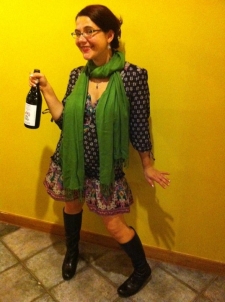This wine region in in North West Italy, or as I like to call it, “The Thigh” of the boot.
Piedmont literally means, “at the foot of the Mountains”. The Mountains we are talking about here are the Alps. To put the region in perspective, in “non-wine” land marks, the principal city of this area is Turin.
This area has a very interesting history that sets it apart from the rest of Italy. From the former Kingdom of Savoy it was one of the driving areas in the 19th century behind the Italian reunification, as well as the start of the Italian industrial revolution. On the flip side however due to its isolated geo-graphical location it was protected during the Habsburg, Bourbon, and papal control which dominated Italian life from the mid 1500’s to the mid 1800’s. One of the most influential areas to Piemonte from the 1500’s to present day is France. There ideas in government, philosophy and winemaking have permeated the life of the Piedmontees, which have many times over brought them fortune while most of the rest of the country was in financial distress.
There are many grapes grown in Piemonte, notably, Barbera, Moscato, Dolcetto, Cortese, Gavi, Arnies, and Favorite, as well as all of the major international varietals of Chard, Pinot Noir, Syrah, Sauvignon Blanc, and Cab Sav. But hands down without question the main grape of this region is Nebbiolo!!! This is the grape that I focusing on in this segment. Nebbiolo is grown in a few notable regions. Langhe is an Umbrella region for which the world famous DOCG’s of Barolo, and Barbaresco live. These two DOCG’s produce some of the worlds finest, if not most famous Nebbiolos’, however there are still great Neb’s at much more modest prices produced in the greater Langhe DOC. There are other great Nebbiolo DOC’s such as Gattinara. But for the purposes of what is easy to find in the USA, and what is easy to purchase on a modest income, which is always my focus, you need to remember Langhe, Barolo, and Barbaresco.
In this segment we are going to be tasting:
Gavarini, Nebbiolo from Langhe 2008, by Elio Grasso.
I chose this wine because it illustrates two points I find important to understand about Piedmont.
- Elio Grasso has maintained the dimensions of a small producer, being equipped with state of the art technology in their winery. I feel that seamlessly blend two sides of an on going argument with Nebbiolo. That of the Traditionalists, who prefer earthy rustic Nebbiolos, and the modernists, who have gone the rooty-tooty-fresh & and fruity route. I feel this winery blends traditional tastes, with modern technology which makes for a cleaner product.
- This wine is from Langhe, and goes for around $25 oppose to it’s Borolo Brothers who can get up to $500’s
Here are the Winery’s Notes on this Wine:
- Municipality of production: Monforte d’Alba
- Grape: Nebbiolo
- First vintage: 1987
- Number of bottles produced each year: 6,500
- Vineyard area under vine: 1.2 hectares
- Aspect and height above sea level: south-facing, 350-380 metres
- Soil type: moderately loose-packed, limestone-based
- Vine training system and planting density: Guyot-trained at 4,500 vines per hectare.
- Average age of productive vines: 15 years
- Grape yield per hectare at harvest: 60 quintals
- Harvest period and method: first 10 days of October, manual harvest. The vinification procedure for Langhe Nebbiolo involves fermentation for 7-8 days in temperature-controlled stainless steel tanks, with daily pumping over. After malolactic fermentation, the wine stays in stainless steel until bottling in April-May. We recommend you drink this wine in the first 3-4 years after the vintage.
Here are my notes:
- Appearance: Clear, Transparent, and Shiny
- Core: Ruby
- Rim: Salmon
- Nose: Healthy
- Medium Aromatics of: Violets, cedar, raspberries, coco powder, and black peppercorns
- Pallet:
- Acid: Medium +
- Tannin: Medium –
- Body: Medium –
- Texture: Wet Swede
- Finish: Medium
- Flavors: Tart cherry, cedar, almonds, Bert’s Bees tomato face wash
- Conclusion: This is a nice light complex wine…. that is still a lightly tight and tart. I feel like it is a freshman in high-school, and although it is fun to have over for dinner now, it will be much more enjoyable in college.
Meal I made to go with it:
- Starter: Robiola Bosina, with fresh figs, & pears.
- Main Course: Nebbiolo Beef Stew over a Cauliflower Mash
- Dessert: Almond & Olive oil crumb cake with a fig/blueberry compote.

